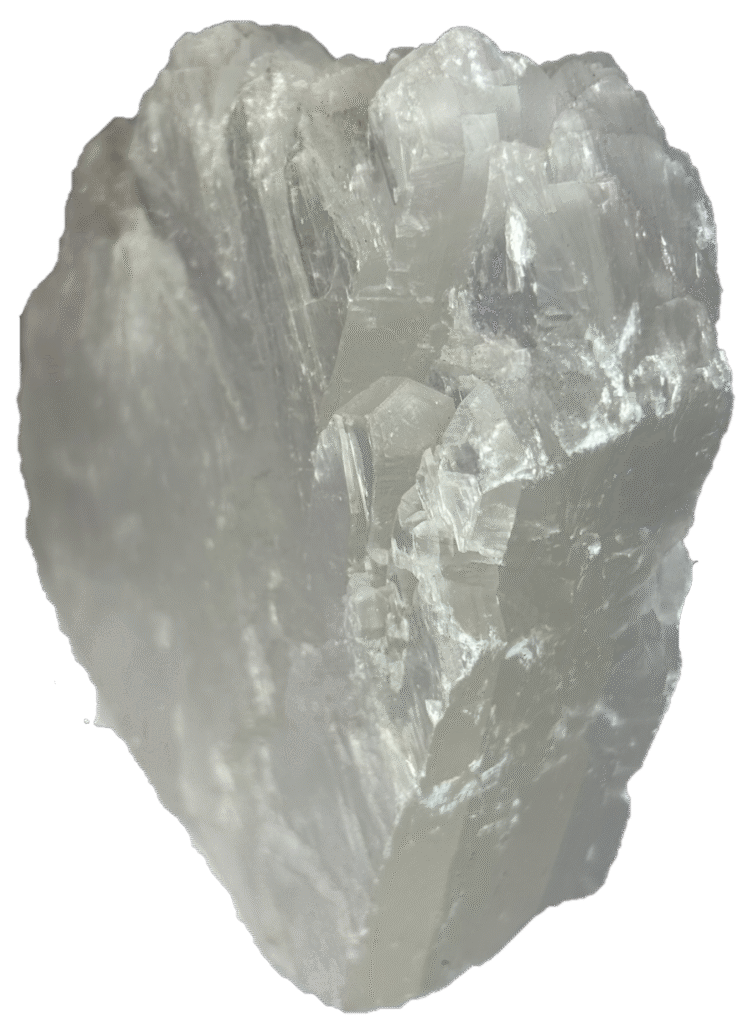
Fish Tail Selenite derives its name from its distinctive, naturally occurring shape that resembles a fish’s tail. This form of selenite – a variety of the soft, translucent gypsum mineral – is also known as “Fin Selenite” or “Tail Selenite” among collectors and metaphysical practitioners. The term “selenite” originates from the Greek goddess of the moon, Selene, reflecting the stone’s luminous, moon-like glow.
Composition and Physical Characteristics
Fish Tail Selenite is composed primarily of gypsum (calcium sulphate dihydrate), with a chemical formula of CaSO₄·2H₂O. This gemstone is prized for its unique crystalline formations and smooth, silky texture.
Physical Properties
- Colour: Typically milky white to translucent, occasionally with subtle iridescence reminiscent of moonlight.
- Hardness: Ranges around 2 on the Mohs scale, which makes it relatively soft and best suited for decorative or metaphysical use rather than daily wear.
- Lustre: Exhibits an earthy, waxy to pearly lustre with a distinctive glow under light.
- Varieties: While Fish Tail Selenite is primarily white, some specimens may show slight hints of blue or silver, enhancing their ethereal appearance.
Locations
Fish Tail Selenite is primarily sourced from regions known for high-quality gypsum deposits. Notable locations include:
- Mexico: Renowned for its impressive selenite formations and crystal clusters.
- Morocco: Offers fine selenite specimens with unique and intriguing fish tail patterns.
- United States: Found in states with rich gypsum deposits, contributing to its availability among collectors.
Archaeological and Significant Finds
Historically, selenite has been used for centuries in spiritual and decorative contexts. Archaeological evidence from ancient Mediterranean cultures shows that selenite was valued for its luminous qualities and was often carved into ritual objects and vases. Though Fish Tail Selenite itself is a more recent classification in the gemstone community, similar naturally occurring formations have been revered for their beauty and symbolic meaning throughout history.
Historical and Current Usage
- Ancient Civilisations: Selenite was used by ancient Egyptians and Romans in the creation of ceremonial artefacts and amulets. Its soft, glowing properties symbolised purity and enlightenment.
- Modern Usage: Today, Fish Tail Selenite is popular in metaphysical circles and interior design. It is used in meditation, as a home décor piece, and in crystal healing practices, symbolising clarity, cleansing, and transformation.
Interesting Facts
- Natural Wonder: Its fish tail shape is naturally occurring, making each piece unique in its formation and energy flow.
- Light Enhancer: Selenite is known for its ability to reflect and amplify light, creating a soft, ambient glow in dark spaces.
- Collectible Rarity: The distinct fish tail formation makes these specimens particularly sought after by collectors.
Folklore, Legends, and Tales
In various cultures, selenite is believed to be a stone of illumination and clarity. Legends suggest that Fish Tail Selenite carries the energy of water – symbolising flow, adaptability, and regeneration. It is often associated with tales of transformation, mirroring the metamorphosis of fish in water and symbolising the journey of the soul through change.
Mystical Healing Properties
Fish Tail Selenite is esteemed in holistic practices for its:
- Energy Cleansing: Clears blockages and purifies the aura, encouraging the free flow of energy.
- Emotional Balance: Assists in releasing emotional tension, promoting calmness and mental clarity.
- Spiritual Insight: Enhances meditation, fostering connection with higher realms and facilitating inner transformation.
Astrology and Zodiac Links
Fish Tail Selenite is linked with the moon and is often associated with:
- Pisces: Enhancing intuition and sensitivity, it resonates well with the watery, empathetic nature of Pisces.
- Cancer: Aiding emotional balance and inner healing, reflecting Cancer’s nurturing qualities.
- Planetary Connection: Its luminous energy echoes that of the Moon, making it a symbol of feminine strength, mystery, and the cyclical nature of life.
Chakra System Connections
This crystal is predominantly connected with the Crown Chakra (Sahasrara), supporting spiritual growth and connection with the divine. It also resonates with the Third Eye Chakra (Ajna), enhancing intuition and inner wisdom, and gently influences the Heart Chakra (Anahata) by promoting emotional balance and compassion.
Birthstone and Wedding Anniversary Links
While Fish Tail Selenite is not traditionally recognised as a birthstone, its luminous qualities make it a favourite for those born under the Moon’s influence. It is occasionally used as a symbolic gift for the 15th wedding anniversary, representing clarity, mutual growth, and the enduring flow of love.

Fish tail selenite
Gentle yet radiant, Fish Tail Selenite channels lunar light and angelic energy. A calming stone for peace, spiritual clarity, and energetic cleansing.
